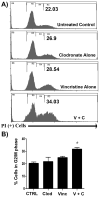Bisphosphonates significantly increase the activity of doxorubicin or vincristine against canine malignant histiocytosis cells
- PMID: 22236140
- PMCID: PMC3278520
- DOI: 10.1111/j.1476-5829.2011.00274.x
Bisphosphonates significantly increase the activity of doxorubicin or vincristine against canine malignant histiocytosis cells
Abstract
Canine malignant histiocytosis (MH) is an aggressive neoplasm of macrophages and dendritic cells. It carries a poor prognosis because of the development of widespread metastasis and poor sensitivity to chemotherapy. Thus, there is a large need for new treatments for MH. We hypothesized that bisphosphonates might be useful to increase the effectiveness of cytotoxic chemotherapy against MH. To address this question, we conducted in vitro screening studies using MH cell lines and a panel of 6 chemotherapy and 5 bisphosphonate drugs. The combination of clodronate with vincristine was found to elicit synergistic killing which was associated with a significant increase in cell cycle arrest. Second, zoledronate combined with doxorubicin also significantly increased cell killing. Zoledronate significantly increased the uptake of doxorubicin by MH cells. On the basis of these findings, we conclude that certain bisphosphonate drugs may increase the overall effectiveness of chemotherapy for MH in dogs.
© 2011 Blackwell Publishing Ltd.
Figures






Similar articles
-
Evaluation of liposomal clodronate for treatment of malignant histiocytosis in dogs.Cancer Immunol Immunother. 2010 Mar;59(3):441-52. doi: 10.1007/s00262-009-0763-y. Epub 2009 Sep 16. Cancer Immunol Immunother. 2010. PMID: 19760220 Free PMC article.
-
Efficacy of vincristine as a rescue therapy for canine histiocytic sarcoma.J Vet Med Sci. 2024 Oct 1;86(10):1100-1104. doi: 10.1292/jvms.24-0218. Epub 2024 Aug 27. J Vet Med Sci. 2024. PMID: 39198188 Free PMC article.
-
A novel canine histiocytic sarcoma cell line: initial characterization and utilization for drug screening studies.BMC Cancer. 2018 Mar 1;18(1):237. doi: 10.1186/s12885-018-4132-0. BMC Cancer. 2018. PMID: 29490634 Free PMC article.
-
[Malignant histiocytosis with complex chromosomal abnormality: successful treatment with CHOP-E chemotherapy].Rinsho Ketsueki. 1991 Mar;32(3):244-9. Rinsho Ketsueki. 1991. PMID: 2041166 Review. Japanese.
-
Malignant lymphomas in the elderly.Clin Geriatr Med. 1997 May;13(2):251-63. Clin Geriatr Med. 1997. PMID: 9115450 Review.
Cited by
-
Synergistic Antitumor Interaction of Risedronate Sodium and Standard Anticancer Agents in Canine (D-17) and Human Osteosarcoma (U-2 OS) Cell Lines.Animals (Basel). 2022 Mar 29;12(7):866. doi: 10.3390/ani12070866. Animals (Basel). 2022. PMID: 35405855 Free PMC article.
-
Evaluation of the drug sensitivity and expression of 16 drug resistance-related genes in canine histiocytic sarcoma cell lines.J Vet Med Sci. 2015 Jun;77(6):677-84. doi: 10.1292/jvms.14-0415. Epub 2015 Feb 21. J Vet Med Sci. 2015. PMID: 25715778 Free PMC article.
-
Inhibition of the mevalonate pathway augments the activity of pitavastatin against ovarian cancer cells.Sci Rep. 2017 Aug 14;7(1):8090. doi: 10.1038/s41598-017-08649-9. Sci Rep. 2017. PMID: 28808351 Free PMC article.
-
Lymph Node Abscessation Secondary to Neoplasia in Two Dogs.Case Rep Vet Med. 2022 Mar 26;2022:4726370. doi: 10.1155/2022/4726370. eCollection 2022. Case Rep Vet Med. 2022. PMID: 35378765 Free PMC article.
-
Tumor-associated macrophages: Prognostic and therapeutic targets for cancer in humans and dogs.Front Immunol. 2023 Apr 5;14:1176807. doi: 10.3389/fimmu.2023.1176807. eCollection 2023. Front Immunol. 2023. PMID: 37090720 Free PMC article. Review.
References
-
- Affolter VK, Moore PF. Canine cutaneous and systemic histiocytosis: reactive histiocytosis of dermal dendritic cells. The American Journal of dermatopathology. 2000;22(1):40–8. - PubMed
-
- MacEwen EG, Withrow SJ. Small Animal Clinical Oncology. Philadelphia PA: Saunders Co; 1996.
-
- Affolter VK, Moore PF. Localized and disseminated histiocytic sarcoma of dendritic cell origin in dogs. Veterinary pathology. 2002;39(1):74–83. - PubMed
-
- Moore PF, Affolter VK, Vernau W. Canine hemophagocytic histiocytic sarcoma: a proliferative disorder of CD11d+ macrophages. Veterinary pathology. 2006;43(5):632–45. - PubMed
Publication types
MeSH terms
Substances
Grants and funding
LinkOut - more resources
Full Text Sources
Other Literature Sources

